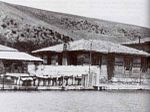Istanbul Bilgi University
1996 establishments in TurkeyBeyoğluEducational institutions established in 1996EyüpIstanbul Bilgi University ... and 1 more
Şişli
Istanbul Bilgi University (Turkish: İstanbul Bilgi Üniversitesi), officially established in 1996, is a private university located in Istanbul, Turkey. The university has 4 campuses centrally-located in Istanbul namely SantralIstanbul, Kuştepe, Dolapdere and Kozyatağı.As of 2020, Istanbul Bilgi University has near 20,000 students and 45,000 graduates; approximately 1,500 academicians; 7 faculties, 3 institutes, 4 schools, 3 vocational schools, and more than 150 programs that provide education to its associate, undergraduate and graduate students.
Excerpt from the Wikipedia article Istanbul Bilgi University (License: CC BY-SA 3.0, Authors).Istanbul Bilgi University
İstanbul Bilgi Üniversitesi İç Yolları,
Geographical coordinates (GPS) Address Nearby Places Show on map
Geographical coordinates (GPS)
| Latitude | Longitude |
|---|---|
| N 41.066666666667 ° | E 28.945833333333 ° |
Address
İstanbul Bilgi Üniversitesi Santral Kampüsü
İstanbul Bilgi Üniversitesi İç Yolları
34060
Türkiye
Open on Google Maps






